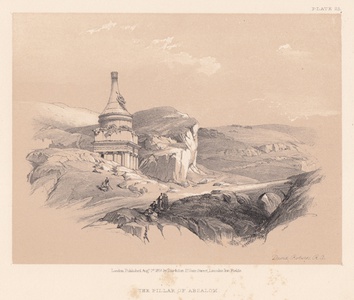| Method | Lithograph with tint stone |
| Artist | after David Roberts |
| Published | London, Published Augt. 1st. 1855, by Day & Son, 17, Gate Street, Lincoln's Inn Fields |
| Dimensions | Image 132 x 173 mm, Sheet 202 x 285 mm |
| Notes |
Plate 25 from Volume 1 of the small format reprint of Roberts' The Holy Land, Syria, Idumea, Arabia, Egypt & Nubia. A view of the so-called 'Tomb of Absalom,' in the Kidron Valley near Jerusalem. Local tradition dating back to at least the Byzantine era ascribes the tomb to Absalom, the rebellious son of King David, based on a description in the Book of Samuel of a pillar that Absalom caused to be set up as a memorial to himself, owing to his lack of sons to carry on his name. In fact, the tomb was probably built during the first century AD at a similar time to its neighbours in the Kidron Valley. The identification of the tomb's original owner is unknown, but it has been suggested that it may once have been the burial place of Herod Agrippa, owing to the architectural similarity between it and the tomb of Herod the Great, Agrippa's grandfather. The tomb's burial-chamber is cut directly from the rock of the Mount of Olives, though the upper register and distinctive conical 'hat' are made of ashlar blocks. Architecturally, it features a combination of Ionic colonnade, Doric frieze, and Egyptian cornice typical of the Eastern Hellenistic style of the first century AD. In Roberts' view, the tomb is shown still half buried amongst the rocky slopes of the Mount of Olives. A pair of guards sit on the slope next to the tomb, while another group are gathered on the opposite side of the road. David Roberts RA (24th October 1796 – 25th November 1864) was a Scottish painter. He is especially known for a prolific series of detailed prints of Egypt and the Near East produced during the 1840s from sketches made during long tours of the region (1838-1840). This work, and his large oil paintings of similar subjects, made him a prominent Orientalist painter. He was elected as a Royal Academician in 1841. The firm of Day & Haghe was one of the most prominent lithographic companies of the nineteenth-century. They were also amongst the foremost pioneers in the evolution of chromolithography. The firm was established in 1823 by William Day, but did not trade under the moniker of Day & Haghe until the arrival of Louis Haghe in 1831. In 1838, Day & Haghe were appointed as Lithographers to the Queen. However, and perhaps owing to the fact that there was never a formal partnership between the two, Haghe left the firm in the 1850's to devote himself to watercolour painting. The firm continued as Day & Son under the guidance of William Day the younger (1823 - 1906) but, as a result of a scandal involving Lajos Kossuth, was forced into liquidation in 1867. Vincent Brookes bought the company in the same year, and would produce the caricatures for Gibson Bowles' Vanity Fair magazine, as well as the illustrations for Cassells's Poultry Book, amongst other commissions. Condition: Light foxing to margins, not affecting image. |
| Framing | unmounted |
| Price | £25.00 |
| Stock ID | 39340 |

